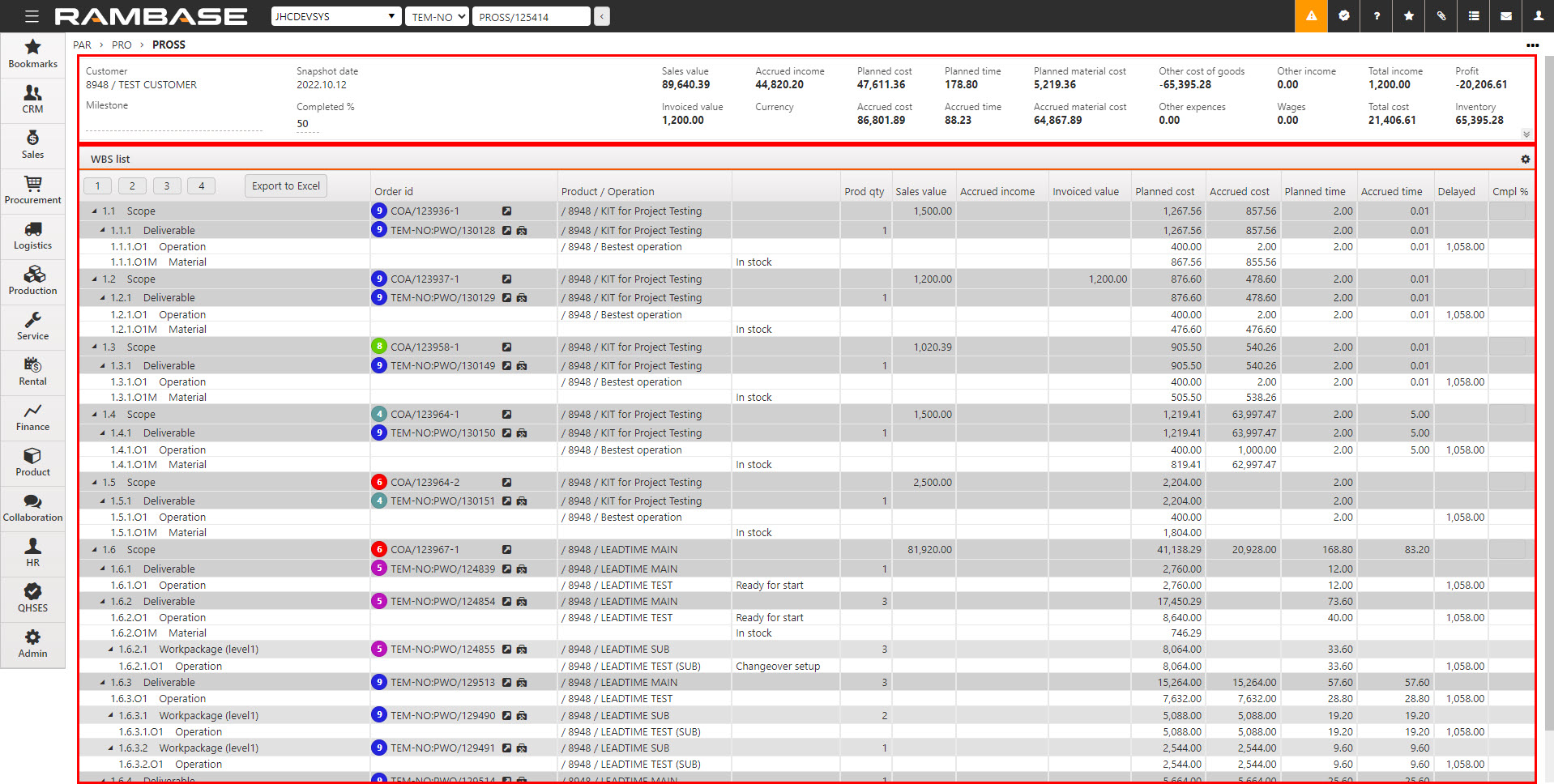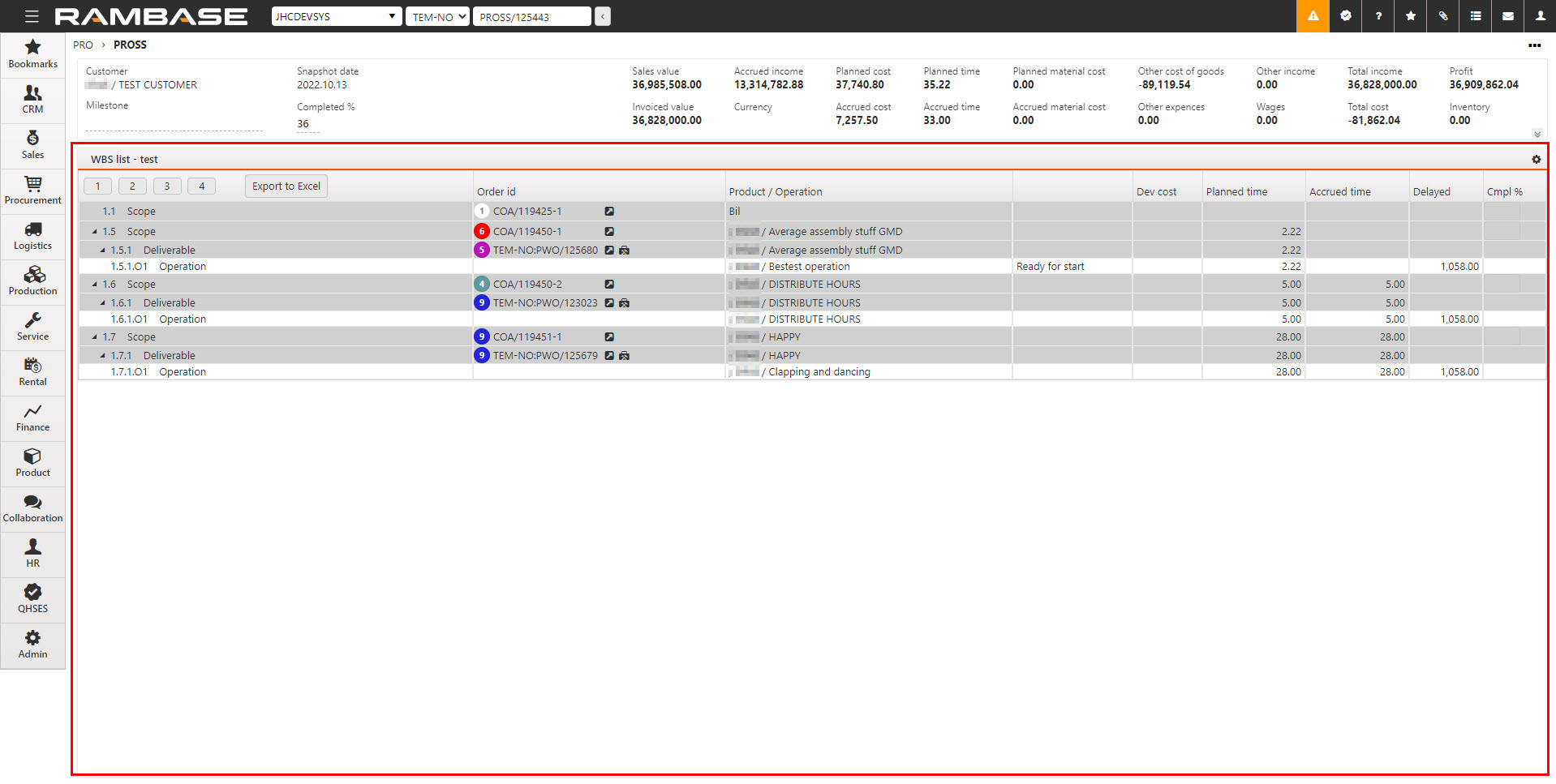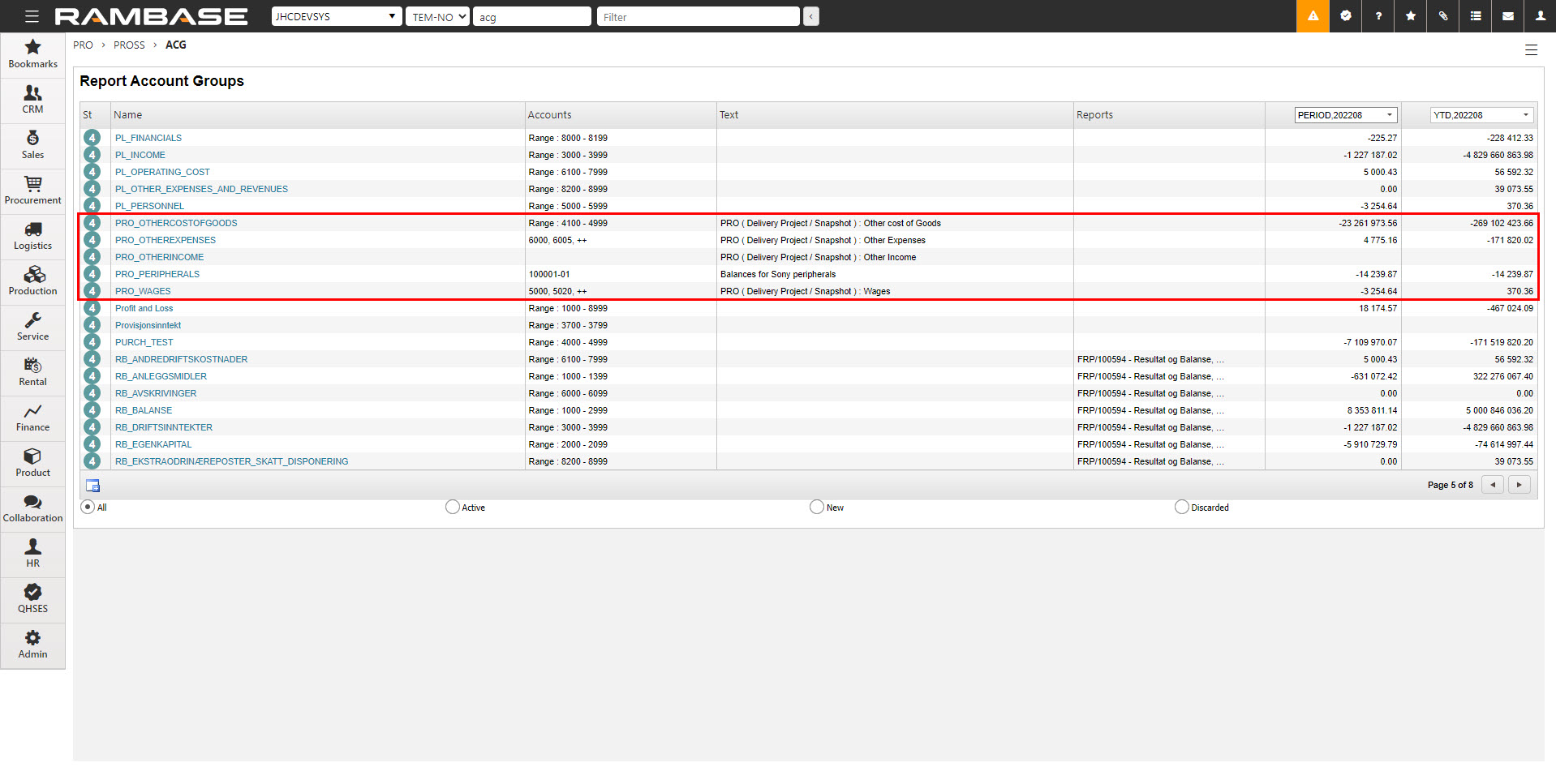Delivery project snapshot (PROSS) application
A snapshot in the Delivery project (PRO) application generates an overview of useful information. The Delivery project snapshot (PROSS) application is used to display even more detailed information.
To open the Delivery project snapshot (PROSS) application, from the Delivery project (PRO) application, click on the Arrow icon or press ENTER on the intended snapshot in the Snapshots tab.
The tables below lists fields, functions and columns used to handle the information provided by the Delivery project snapshot (PROSS) application.
Overview

The user can select which columns are to be displayed by clicking the Column settings icon. The selection of columns can be saved to templates by selecting the + Add template to list option in the Column settings. The template can be selected by clicking the Current view drop-down list.
The Delivery project snapshot (PROSS) will display the selected template upon reentering the application.
Header
The header is found at the top of the application and is comprised of some editable fields, and mostly informational fields.
Field | Description |
|---|---|
Customer | An informational field displaying the customer name. |
Milestone | An input field where the user can define the project milestone, the snapshot represents. |
Snapshot date | Date the snapshot generated. |
Completed % | An input field where the user can define the snapshot's representation in project completion, in percent. |
Sales value | The sum of the total value of the connected Sales orders (COA). |
Invoiced value | The sum of all Customer invoices (CIN) connected to the Delivery project (PRO). |
Accrued income | Calculated based on completed percent. Can be overwritten by entering adding a percentage to the Completed % field in the header. |
Initial planned cost | The expected cost from the Product structures (KITART), which provides an important view of the expected production cost before work starts, or accruals are available. |
Currency | The currency derived from the Sales order (COA). |
Planned cost | Planned production cost. |
Accrued cost | Sum of all ongoing and finished productions. The Accrued cost is also split and detailed with the following columns:
|
Planned time | Planned time on all connected Production work orders (PWO). |
Accrued time | Sum of time on all connected and finished Production work orders (PWO). |
Planned material cost | Planned material cost from Production work orders (PWO). |
Accrued material cost | Cost of all materials that are picked for Production work order (PWO) and sub Production work orders (PWO). |
Other cost of goods | Connected to a dedicated Report account group (ACG) based on the users inclusion of General ledger (GL) accounts. Read more in the Limitations on using the Report account groups (ACG) section. |
Other expenses | Connected to a dedicated Report account group (ACG) based on the users inclusion of General ledger (GL) accounts. Read more in the Limitations on using the Report account groups (ACG) section. |
Other income | Connected to a dedicated Report account group (ACG) based on the users inclusion of General ledger (GL) accounts. Read more in the Limitations on using the Report account groups (ACG) section. It is recommended to exclude General ledger (GL) accounts that are used for Customer invoices (CIN). |
Wages | The Wages field displays cost related to personnel cost like wages, but also other costs like travel can be put into this group. The Wages field is presented together with other key-figures for the Delivery project (PRO). This field is connected directly to the General ledger (ATR) through the account group in the Report account groupd (ACG) application: ACG/PRO_WAGES. |
Total income | (InvoicedAmount + OtherIncome) |
Total cost | (Accrued.TotalCost + OtherCostOfGoods + Wages + OtherExpences) |
Profit | (TotalIncome - TotalCost) |
Inventory | Inventory value for a Delivery project (PRO) is sum of all inventory on the related Finance project (PRJ). |
The Work breakdown structure (WBS) list

The user can select which columns are to be displayed by clicking the Column settings icon. The selection of columns can be saved to templates by selecting the + Add template to list option in the Column settings. The template can be selected by clicking the Current view drop-down list.
The Delivery project snapshot (PROSS) will display the selected template upon reentering the application.
The available columns and functions are described in the table below.
Icon | Column | Description |
|---|---|---|
| Level | Decide the levels displayed in the WBS list. Click the 1 button to display only the Scope level which includes the inital Sales order (COA). |
| Level | Decide the levels displayed in the WBS list. Click the 2 button to display the Scope and Deliverable levels which includes the inital Sales order (COA), the triggered or linked Production work order (PWO). |
| Level | Decide the levels displayed in the WBS list. Click the 3 button to display the Scope, Deliverable and Operation levels which includes the inital Sales order (COA), the triggered or linked Production work order (PWO) and the operation and material information. |
| Level | Decide the levels displayed in the WBS list. Click the 4 button to display the Scope, Deliverable, Operation, Material levels including all sub-productions. |
| Level | Export to excel. Click the Export to excel button to generate and download a .xlsx file. This function will only export the selected columns in the Column settings. |
| Status | An icon indicating the status of the Sales order (COA) or Production work order (PWOD). |
Order id | Lists the order and identification number of the document, in example PWO/00000, Click the View icon to enter the primary document or alternatively type the order and identification number in the Program field. | |
Order id | Clicking the View icon will open the relevant application for the order. A Sales order (COA) id, in example COA/00000, will open the Sales order (COA) application on the order in question. A Production work order (PWOD) id, in example PWO/00000, will open the Production work order (PWOD) application on the work order in question. | |
| Order id | Clicking the Structure icon will open the KITDOC application and display the structure of the part being produced by the Production work order (PWOD). |
Product / Operation | An informational field displaying the name of the product being produced and name of the related operation. | |
Operation / Materials status | This unnamed column, in the Delivery project snapshot (PROSS) application, displays information which can be used to identify which Production work orders (PWO) to prioritize by stating the operation and material status like; Ready to start or In stock. | |
Prod qty | The quantity being produced by the connected Production work orders (PWO). | |
Sales value | The sum of the total value of the connected Sales orders (COA). | |
Accrued income | Calculated based on completed percent. | |
Invoiced value | The sum of all Customer invoices (CIN) connected to the Delivery project (PRO). | |
Initial planned cost | The expected cost from the Product structure (KITART), which provides an important view of the expected production cost before work starts, or accruals are available. | |
Planned cost | Planned production cost. | |
Accrued cost | Sum of all ongoing, finished and shipped Production work orders (PWO). The Accrued cost is also split and detailed with the following columns:
| |
Accrued cost active | Accrued cost of all active, in Status 5 and 6, Production work orders (PWO). | |
Accrued cost finished | Cost of all completed Production work orders (PWO), in Status 9, that are forwarded to stock but not yet shipped to customer. | |
Accrued cost shipped | Cost of shipped products. | |
Deviation total cost | This is the difference between total planned cost and accrued cost for each element and total difference at each work package and deliverable level. Only for completed sub levels and at the scope. | |
Accrued total cost % | Accrued cost in percentage of planned cost for elements with deviation. | |
Planned time | Accrued time per operation and total accrued time for each work package and deliverable level. | |
Accrued time | Accrued time per operation and total accrued time for each work package and deliverable level. | |
Deviation hours | The difference between operation planned and accrued time and total difference at each work package and deliverable level. Only for completed sub levels and at the scope. | |
Accrued hours % | Accrued hours in percentage of planned cost for elements with deviation. | |
Delayed days | Operation delay in days. | |
Completed % | Manual input at scope level. This is reset to blank by each new snapshot. | |
Completed % calculated | Calculated completed percentage for the deliveries. | |
Requested delivery | Requested delivery date for the customer order item. | |
Confirmed delivery | Confirmed delivery date for the customer order item. |
Common for columns connected to an Report accounting group (ACG)
It is possible to register cost and income elements directly to the general ledger and connect them to the Delivery project (PRO). To be able to do so, there are a few conditions to consider.
The Delivery project needs to be connected to a Finance project (PRJ).
Values can be registered to the Delivery project (PRO) using accounts that are defined in the Report account groups (ACG) mentioned below.
Report account groupd (ACG) | Delivery project snapshot (PROSS) field |
|---|---|
PRO_OTHERCOSTOFGOODS | Other cost of goods |
PRO_OTHEREXPENSES | Other expenses |
PRO_OTHERINCOME | Other income |
PRO_WAGES | Wages |
These are the fields that are displayed in the Delivery project snapshot (PROSS) application header.
Register either directly to the general ledger using a General ledger posting (ATR) or through a Sales invoice (CIN) or Supplier invoice (SIN). Read about how to book a cost invoice here.
Note the Report account groups (ACG) listed in the application.

Limitations on using the Report account groups (ACG)
Which accounts to group in the Report account groups (ACG) application, can be selected at will, but should should never include accounts that are meant for value flow.
Account groups that includes these Product (ART) types must be excluded:
Part (type P)
Material (type M)
Consumption parts (type C)
Kit and kit assemblies (type K and KA)







